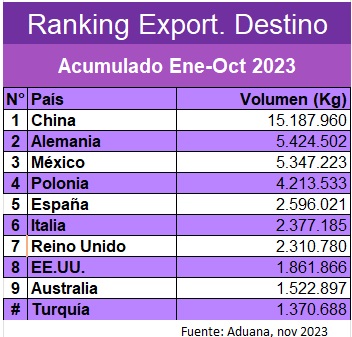In the first 10 months of the year, exports of this superfood reached 79 countries, totaling 57,816 metric tons (MT).
Chile, the main exporter of prunes in the world, has China, Germany and Mexico among its three main markets for this superfood, representing between the three, 45% of the total volume of shipments abroad.
China, with its 15,188 metric tons, almost triples the shipments from Germany and Mexico (see box), being the main importer of Chilean prunes almost every month of the year, except for the first quarter of 2023.
Other relevant destinations, within 79 countries on the five continents to which this fruit is sent, are Poland, Spain, Italy, the United Kingdom, the United States, Australia and Turkey. Poland is recognized as a good consumer, but also as a good collection center, which is then sent to other neighboring nations.
Russia, a traditional buyer of Chilean prunes, appears in 11th place, after normalizing its orders that were altered in 2022, due to the war with Ukraine that began in February of that year. After Russia comes Holland, the last country that has imports of more than 1,000 MT.
Then, three Latin American countries appear followed as relevant destinations: Colombia, Brazil and Guatemala, which have more than 900 metric MT received to date.
Europe as a whole, without considering Russia, receives 23,757 metric tons from Chile, considering a total of 26 countries.
The information is delivered by Customs (Aduana), a service of the Government of Chile.
Thanks to an area cultivated with European plum trees that reaches 12,530 hectares, Chile is capable of a total production of plums of more than 100,000 MT per year, of which a significant percentage is destined for fresh plums, to be marketed in China, according to Chileprunes, Guild Association of Prunes Processors and Exporters of Chile, a union that brings together more than 70% of dried plum exports.
It has more than 100 producers of various sizes, with areas ranging from 3 hectares to others with around 270, totaling more than 2,500 hectares. The average is 10 to 15 hectares per producer, 65% corresponding to partner producers and the other 35% external.



